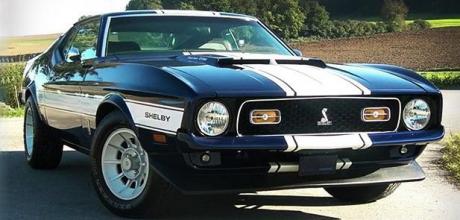1971 Shelby Mustang Europa GT500
When is a Shelby Mustang not a Shelby Mustang? When it’s a Shelby Mustang Europa GT500… only it was a Shelby Mustang, well, sort of…. Richard Heseltine explains.
From here to obscurity
Richard Heseltine’s weird and wonderful American cars from the past.
It was the muscle from Brussels; a Ford Mustang with a legendary name attached that nevertheless flew below the radar. The car pictured here was conceived by Claude Dubois, a Belgian car dealer and racer whose on-track exploits stretched to a class win in the 24 Hours of Le Mans among other triumphs. He was a works driver for a variety of marques, and also a concessionaire for the likes of de Tomaso and Shelby American. He rounded out his circuit career at Zandvoort in 1967 with an outright win aboard a Cobra, and reckoned that he imported as many as 150 Shelby products of all kinds up until 1970.
That same year saw Ford end its association with Carroll Shelby, much to the chagrin of Dubois who was good friends with the Texan. Dubois had a small but loyal clientele who wanted Shelby-ised Pony Cars which prompted him to approach motor racing’s answer to P T Barnum with a proposal: would Shelby licence his name and allow him to produce such a car strictly for the home market? He was receptive.
Plans changed soon thereafter, however, the intention now being to sell a new product beyond Belgium’s borders, but not the USA. Enter the Europa GT500 that was announced at the Brussels Motor Show in January 1971 with Shelby on hand for the big reveal.
Cars were based on the Mach 1 platform, or rather ‘SportsRoof’ fastbacks with the choice of a 351cu in Windsor small-block, or the 428cu in Cobra-Jet unit. Donors were sourced from Detroit dealer Bob Ford, standard equipment stretching to adjustable ‘racing-style’ Koni shock absorbers along with Avon low-profile (all things being relative) tyres.
Throw in some slot-mags, front and rear spoilers and go-faster stripes and it looked quite the ticket. However, there were a few obstacles that stood in the way of success. For starters, it wasn’t strictly legal.
As was once customary, a degree of chicanery was involved in importing and then certifying the car. Dubois used homologation paperwork for the 1969 Shelby Mustang and, strictly speaking, the car wouldn’t have passed increasingly stringent emissions tests without it. Also, it was egregiously expensive. Sales never got much beyond a trickle, and no two cars were alike. One was purportedly equipped with a 429cu in V8, complete with Drag Pack, that produced around 400bhp. As many as three convertibles were made, all of which were sold in the Netherlands (one of which was stolen almost immediately, never to be seen again).
Dubois threw in the towel in 1972, having become disenchanted with the scheme. As to how many cars were built, it depends on whose estimates you credit. Some sources claim it was 12 to 14, others as few as nine. Dubois for his part claimed not to know for sure. He claimed that his records were appropriated in later years along with his brochures and other ephemera while he was attempting to write a book about his exploits (which stretched to returning to circuit racing when in his eighth decade). Incidentally, he wasn’t done with American machinery following the demise of the Europa GT500. Dubois was the official concessionaire for Chrysler products from the mid- to late-1980s on. It proved to be an inspired move because at one point he sold more than 3000 cars per year via a network of 36 dealers.


